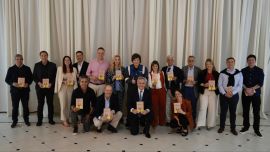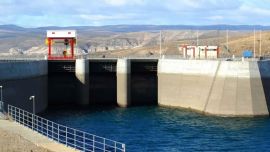The road that leads to some of Argentina’s largest ports and soybean processing plants is usually filled with 2,000 trucks every day at this time of year. On a Tuesday afternoon late last month, there were only a handful.
After the worst drought in six decades left the world’s largest exporter of soy products with the smallest crop in nearly 25 years, farmers are running out of the very commodity that fuels Argentina’s economy.
Soybean factories owned by US trading giants Cargill Inc and Bunge Global SA, as well as China’s Cofco International and local processor Vicentin are all operating at reduced capacity or have shut altogether. With almost nothing to export, Argentina is being starved of the dollars it desperately needs, spelling trouble for the new president set to be elected this weekend.
“The drought situation in Argentina is catastrophic for us,” Gustavo Idigoras, head of CIARA-CEC, a lobby group representing some of the country’s top soy crushers and crop shippers, said in an interview in Buenos Aires. “The real impact of the drought for crushers is from this quarter on.”
The situation couldn’t be more dire. The Board of Trade in the port city of Rosario, which houses most of Argentina’s soybean processing plants, estimates the economic hit from lower crop exports at US$16 billion — all at a time when a new president will need as many dollars as possible to shore up an economy grappling with inflation of 143 percent.
Juan Luciano, an Argentine national and chief executive officer of Chicago-based Archer-Daniels-Midland Co, had already warned farmers in the country were running out of inventory. In a call with analysts at the end of October, he predicted Latin America’s second-largest economy would run out of soybeans this month.
He was right. The vast parking lots on the road to the crushing plants — clustered around Rosario — are pretty much deserted. On any given day in recent weeks, truck deliveries from the Pampas crop belt were scant.
Truck deliveries
Take the first Friday of November, when just 382 soy cargoes rolled into the Rosario area, 59 percent fewer than the same day a year earlier, according to trucking agency AgroEntregas. That was one of the worst days for deliveries recently. The drought also curbed arrivals of other crops.
As a result, several soy plants are already bringing forward annual maintenance, putting production lines out of action earlier than normal, said Julian Echazarreta, a director at ACA, a major agriculture cooperative. Idle capacity at plants could reach as much as 70 percent, according to the Rosario Board of Trade.
Vicentin, once the crown jewel of Argentina’s soy processing industry, shut its San Lorenzo plant for maintenance earlier than usual, said Estanislao Bougain, a board member at the company. The Ricardone facility, which crushes both soy and sunflower seeds, is also down. While the firm is in bankruptcy proceedings, it has allowed other exporters to use its factories to keep some cash flowing in.
Cargill is running at least one of its processing plants in Argentina at reduced capacity, Cofco is operating mostly out of its Timbues facility, and Bunge isn’t running the crush plant at its T6 facility, said people familiar with the matter, who asked not to be identified discussing confidential market information key to competition.
Cargill and Cofco declined to comment. Bunge didn’t reply to a request for comment.
As the soy industry grinds to a halt, neighbouring Brazil has overtaken Argentina as the world’s top exporter of soybean meal — a key ingredient in animal feed — for the first time since 1998.
The economic impact — worsened by an unexpectedly small wheat harvest that’s currently being gathered — is huge. Exports of all crops including soybeans, wheat and sunflower seeds are forecast at just US$25.5 billion, 39 percent less than in the 2021-2022 season, the Rosario exchange estimates.
Farmer sales
To be sure, farmers still have about 2.5 million metric tons of soybeans in their hands before the new harvest starts in April. While that’s less than half what’s usual at this point in the year, it could help some factories restart should the new president devalue the peso after the elections.
“When we can lock in margins, we’ll run,” Greg Heckman, CEO of Bunge, said in an interview in Minneapolis earlier this month, declining to comment on the current status of its Argentine plants and terminals.
There will also likely be more imports next quarter from neighbouring Paraguay, Vicentin’s Bougain said. At that point, the company should resume tolling operations. Argentina has also imported record supplies from Brazil this year.
For now, it’s going to be a long wait for fresh soybeans — which haven’t even been planted yet. And the pain is only going to get deeper as more factories run out of supplies.
“For sure the industry will close some production lines,” said Idigoras of Ciara-Cec.
related news
by Jonathan Gilbert & Isis Almeida, Bloomberg





















Comments